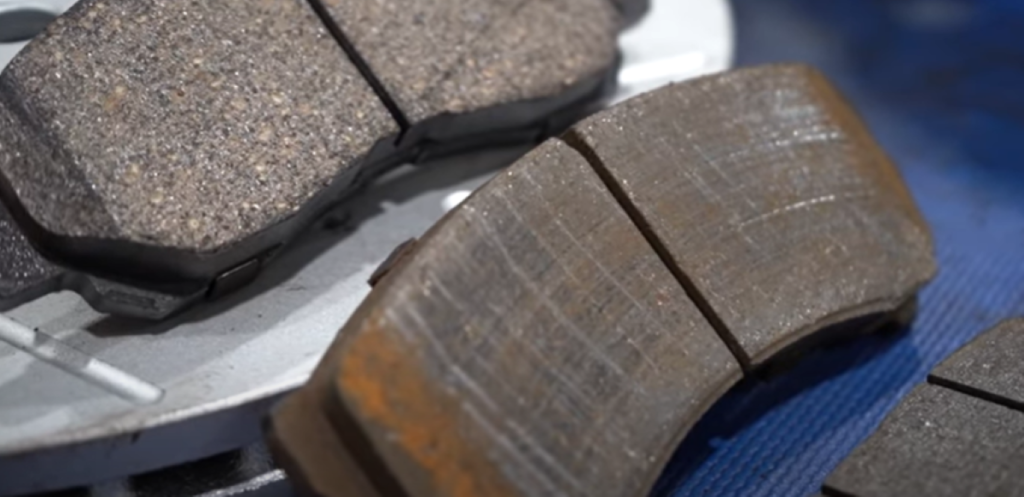Brake pads and brake shoes used to be made of asbestos, but that proved to harm the environment and people’s health. Now we have three brake pads to choose from: organic, ceramic, and semi-metallic. But which is best for you? This post and video reviews the difference between these types of brake pads, the topic of ceramic vs. semi-metallic brake pads and which is better for your vehicle, and the different kinds of rotors available.
3 Different Types of Brake Pads

Organic Brake Pads
Organic brake pads are basically made of wood, rubber, glass, and fiber. These brake pads are better for daily driving because they will wear out faster and can’t take a lot of heat. They are not ideal for performance cars or vehicles that tend travel with heavy loads.
Ceramic Brake Pads
Ceramic brake pads are made of ceramic and might have copper in them to disperse the heat, but, generally, they’re made of ceramic. They are pretty equal to semi-metallic pads in a lot of areas, but the main difference is that ceramic is made of 90% ceramic and causes no dust.
You’ll find these on higher end vehicles or cars with expensive rims. Even if your car didn’t come with them, you can purchase aftermarket pads, like ones available at 1aauto.com, and use them on your car.
Semi-Metallic Brake Pads
To test if a brake pad is ceramic or semi-metallic, use a magnet. The magnet will connect to semi-metallic pads. Semi-metallic pads have iron, copper, steel, and 30 to 70 percent of metal.
Ceramic vs Semi-Metallic Brake Pads: Which Pads Are Better for My Car?
Ceramic Brake Pads
If your car has an aluminum brake caliper and not a steel one, you must use ceramic brake pads. You can tell if the caliper is aluminum with a magnet. The magnet will stick to steel, but not to aluminum.
If you put a semi-metallic brake pad in an aluminum brake caliper, it will make a lot of noise. It will work fine and brake fine, but you’ll hear an annoying sound every time you brake that can’t be fixed until pads are worn. For steel calipers, you can use ceramic or semi-metallic brake pads.
A lot of performance vehicles with larger tires will likely have slotted rotors with ceramic brake pads.
Semi-Metallic Brake Pads
If you have a vehicle used for towing, like a truck, you’ll probably have semi-metallic brake pads. These brake pads can handle and perform under hot temperatures. While ceramic brake pads can still handle hot temperatures, semi-metallic pads are better at performing when the brakes are hot and you need to stop with the extra weight from the trailer behind you.
Organic brake pads are not the best option for vehicles that tow. The vehicle won’t be able to perform with all the heat at the brakes needed for towing, and it will break down and wear out the pads faster.
Can I Install Semi-Metallic or Ceramic Brake Pads on My Car?
If you have a steel brake caliper, you can use either ceramic or semi-metallic brake pads. If you place semi-metallic pads in an aluminum brake caliper, it will make a lot of noise that cant be fixed. To tell if you have a steel or aluminum brake caliper, place a magnet on the caliper. A magnet will stick to a steel caliper, but not an aluminum one.
Different Rotors: What Kind of Rotors Should I Install on My Car?
There are different rotors such as drilled, slotted, and vented rotors, drilled and solid rotors, and slotted and drilled solid rotors. Here’s the difference between them and how you’ll know what’s best for you.
Drilled and Slotted Rotors

On performance cars, drilled and slotted rotors cool down extra fast with no brake fade. Brake fade is an unsafe phenomena that happens when the brakes get too hot from frequent braking to stop the car effectively. These rotors will help for situations where quick and frequent braking is needed. They will also last longer, cool sooner, wear less material, and have a coating to prevent rust.
Solid Rotors

A solid rotor 99 percent of the time will be found at the rear. This is because there’s no weight, so they’ll do their job easily without much of a fuss.
Vented Rotors

Vented rotors are common and are on most vehicles. These rotors have slotted vents to dissipate the heat that comes from frequent braking, like during city driving. If the rotor doesn’t dissipate the heat, you’ll get brake fade, meaning your car won’t stop within the time needed and the heat will wear down the pads faster.
Vented rotors can rust, rot and swell up, causing them to not disperse heat properly and cause pulsating brakes. When this happens, you can’t turn the rotor because it will return, so we recommend replacing the rotor instead.
Learn How to Fix Your Car
Find out how to fix your own car with our how-to videos. Our videos have steps from experienced mechanics to help you diagnose and install parts on hundreds of makes and models.
Read More Automotive Content
- Brake Installation Tips: How to Change Brake Pads, Brake Rotors, Brake Calipers, and More Correctly
- How to Double and Bubble Flare Brake Lines
- How to Check for Bad Transmission Fluid
- Reddish Fluid Leaking From Your Car?
Shop Parts and Tools


